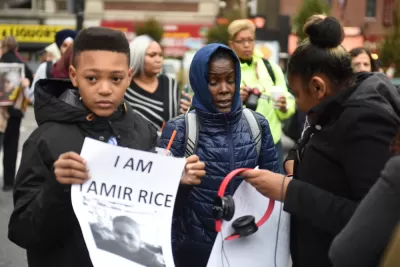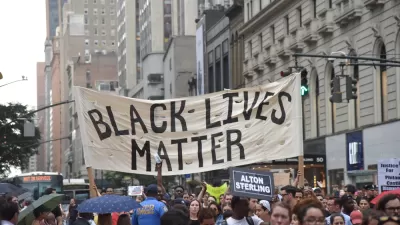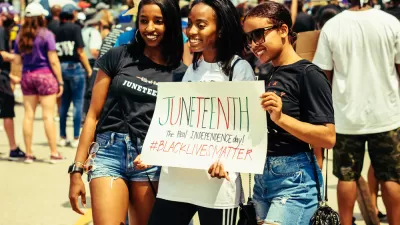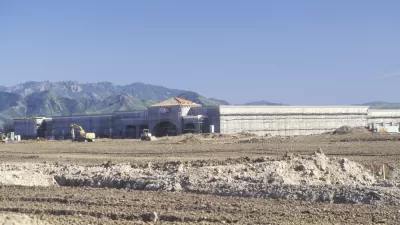Sheryl-Ann Simpson from Carleton University, Justin Steil from MIT, and Aditi Mehta from the University of Toronto write about a recent article they co-authored in the Journal of Planning Education and Research.

Mass incarceration is a defining condition of the United States today. More than 2 million people are currently incarcerated in the U.S., a country with only 4 percent of the world’s population, but 20 percent of the people imprisoned worldwide. There are deep class and racial inequities and injustices in terms of who ends up behind bars. The likelihood of being incarcerated over a lifetime is currently one in three for Black men and one in six for Latino men, compared with one in 17 for white men. While white folks are underrepresented in the incarcerated population of every state except Hawai'i relative to their representation in the state population, Black folks are overrepresented in every state except Montana, and some combination of Indigenous, Latina-x-o, and Asian American folks are overrepresented in 36 states.
Mass incarceration is about more than jails and prisons. Whole systems of policing, of courts, and of policy making together produce the racially and economically unequal structure of mass imprisonment. The institutions at the heart of mass incarceration are intertwined with broader structures of racial and economic control that maintain white supremacy and economic exploitation.
Our article, "Planning beyond Mass Incarceration," provides the introduction to a special issue of the Journal of Planning and Education Research that examines the relationships between planning and this broader system of mass incarceration. We outline some of the key aspects of planning practice that have supported and created conditions for the racial inequities in the system. For example, one of the first U.S. land use or zoning regulations passed in 1910 in Baltimore made it a crime for any ‘colored person’ to take up residence with, or on a block where white people lived. The law did take care to make a specific exception for domestic servants. Similar zoning ordinances spread throughout the country, and created conditions where just the presence of Black people in white space was criminalized.
While contemporary planning practice might not be as explicitly tied to white supremacist ideas as early zoning ordinances, planning practice still enables conditions that criminalize Black, Indigenous, and other people of color going about daily life and securing health and livelihood. Planning practices that lead to disinvestment in communities of color, development that prioritizes economic growth and white wealth accumulation ahead of all other concerns, and that ignores, or is silent about the ways in which policing harms marginalized communities all create conditions for, contribute to, and support systems of mass incarceration.
Articles in the collection lay out the mechanics of how planning practices led to over-policing, including exclusion and surveillance of communities of color, as well as offer ideas and examples for planning practice and education that lean into equity, advocacy, and racial justice traditions to dismantle systems of mass incarceration and imagine new structures that truly create safety for all of the public.
This special issue presents ideas for planning practices that support the health and livelihoods of people leaving jails and prisons, including through housing and employment, and examples of planning education that highlight how bringing together incarcerated and non-incarcerated students can help build new understandings of the city and identities in it. The articles also include examples of what defunding systems of mass incarceration looks like and the opportunities for safety, sanctuary and community development that open up when the focus shifts away from custody and control. Finally, the articles present ideas that move towards abolition and refusal, drawing on Indigenous feminist practices that envision decolonial ideals of safety.
The articles in the special issue ask planners to consider their own role in this system of mass incarceration: Does the solution you are proposing add resources to the system of mass incarceration, funding for police body cameras or new prison development? Or rather does your solution put resources and control back into community-centered definitions of safety through restorative justice, through funding for community services, schools and affordable housing?
Globally, uprisings and protests are drawing attention to police violence, and the movement for Black lives. We started work on this collection almost two years ago and it traces events and community-based organizing that have been going on for decades. To truly honor the people who have been killed and otherwise harmed by systems of mass incarceration we must commit to continuing to pay attention even after the topic stops trending, commit to withdrawing our support for this dehumanizing system, and commit to working towards real—material, bodily, spiritual—forms of resistance, refusal, and re-creation.

Planetizen Federal Action Tracker
A weekly monitor of how Trump’s orders and actions are impacting planners and planning in America.

Chicago’s Ghost Rails
Just beneath the surface of the modern city lie the remnants of its expansive early 20th-century streetcar system.

San Antonio and Austin are Fusing Into one Massive Megaregion
The region spanning the two central Texas cities is growing fast, posing challenges for local infrastructure and water supplies.

Since Zion's Shuttles Went Electric “The Smog is Gone”
Visitors to Zion National Park can enjoy the canyon via the nation’s first fully electric park shuttle system.

Trump Distributing DOT Safety Funds at 1/10 Rate of Biden
Funds for Safe Streets and other transportation safety and equity programs are being held up by administrative reviews and conflicts with the Trump administration’s priorities.

German Cities Subsidize Taxis for Women Amid Wave of Violence
Free or low-cost taxi rides can help women navigate cities more safely, but critics say the programs don't address the root causes of violence against women.
Urban Design for Planners 1: Software Tools
This six-course series explores essential urban design concepts using open source software and equips planners with the tools they need to participate fully in the urban design process.
Planning for Universal Design
Learn the tools for implementing Universal Design in planning regulations.
planning NEXT
Appalachian Highlands Housing Partners
Mpact (founded as Rail~Volution)
City of Camden Redevelopment Agency
City of Astoria
City of Portland
City of Laramie






























